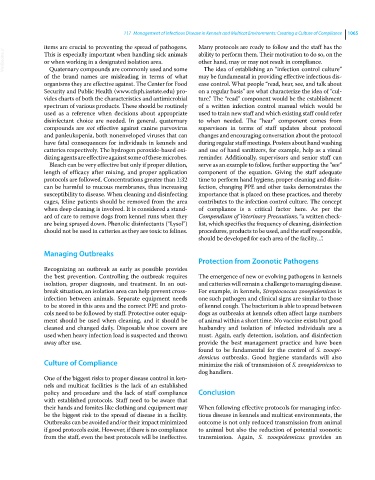Page 1127 - Clinical Small Animal Internal Medicine
P. 1127
117 Management of Infectious Disease in Kennels and Multicat Environments: Creating a Culture of Compliance 1065
items are crucial to preventing the spread of pathogens. Many protocols are ready to follow and the staff has the
VetBooks.ir This is especially important when handling sick animals ability to perform them. Their motivation to do so, on the
other hand, may or may not result in compliance.
or when working in a designated isolation area.
Quaternary compounds are commonly used and some
The idea of establishing an “infection control culture”
of the brand names are misleading in terms of what may be fundamental in providing effective infectious dis
organisms they are effective against. The Center for Food ease control. What people “read, hear, see, and talk about
Security and Public Health (www.cfsph.iastate.edu) pro on a regular basis” are what characterize the idea of “cul
vides charts of both the characteristics and antimicrobial ture.” The “read” component would be the establishment
spectrum of various products. These should be routinely of a written infection control manual which would be
used as a reference when decisions about appropriate used to train new staff and which existing staff could refer
disinfectant choice are needed. In general, quaternary to when needed. The “hear” component comes from
compounds are not effective against canine parvovirus supervisors in terms of staff updates about protocol
and panleukopenia, both nonenveloped viruses that can changes and encouraging conversation about the protocol
have fatal consequences for individuals in kennels and during regular staff meetings. Posters about hand washing
catteries respectively. The hydrogen peroxide‐based oxi and use of hand sanitizers, for example, help as a visual
dizing agents are effective against some of these microbes. reminder. Additionally, supervisors and senior staff can
Bleach can be very effective but only if proper dilution, serve as an example to follow, further supporting the “see”
length of efficacy after mixing, and proper application component of the equation. Giving the staff adequate
protocols are followed. Concentrations greater than 1:32 time to perform hand hygiene, proper cleaning and disin
can be harmful to mucous membranes, thus increasing fection, changing PPE and other tasks demonstrates the
susceptibility to disease. When cleaning and disinfecting importance that is placed on these practices, and thereby
cages, feline patients should be removed from the area contributes to the infection control culture. The concept
when deep cleaning is involved. It is considered a stand of compliance is a critical factor here. As per the
ard of care to remove dogs from kennel runs when they Compendium of Veterinary Precautions, “a written check
are being sprayed down. Phenolic disinfectants (“Lysol”) list, which specifies the frequency of cleaning, disinfection
should not be used in catteries as they are toxic to felines. procedures, products to be used, and the staff responsible,
should be developed for each area of the facility…”.
Managing Outbreaks
Protection from Zoonotic Pathogens
Recognizing an outbreak as early as possible provides
the best prevention. Controlling the outbreak requires The emergence of new or evolving pathogens in kennels
isolation, proper diagnosis, and treatment. In an out and catteries will remain a challenge to managing disease.
break situation, an isolation area can help prevent cross‐ For example, in kennels, Streptococcus zooepidemicus is
infection between animals. Separate equipment needs one such pathogen and clinical signs are similar to those
to be stored in this area and the correct PPE and proto of kennel cough. The bacterium is able to spread between
cols need to be followed by staff. Protective outer equip dogs as outbreaks at kennels often affect large numbers
ment should be used when cleaning, and it should be of animal within a short time. No vaccine exists but good
cleaned and changed daily. Disposable shoe covers are husbandry and isolation of infected individuals are a
used when heavy infection load is suspected and thrown must. Again, early detection, isolation, and disinfection
away after use. provide the best management practice and have been
found to be fundamental for the control of S. zooepi-
demicus outbreaks. Good hygiene standards will also
Culture of Compliance minimize the risk of transmission of S. zooepidemicus to
dog handlers.
One of the biggest risks to proper disease control in ken
nels and multicat facilities is the lack of an established
policy and procedure and the lack of staff compliance Conclusion
with established protocols. Staff need to be aware that
their hands and fomites like clothing and equipment may When following effective protocols for managing infec
be the biggest risk to the spread of disease in a facility. tious disease in kennels and multicat environments, the
Outbreaks can be avoided and/or their impact minimized outcome is not only reduced transmission from animal
if good protocols exist. However, if there is no compliance to animal but also the reduction of potential zoonotic
from the staff, even the best protocols will be ineffective. transmission. Again, S. zooepidemicus provides an

